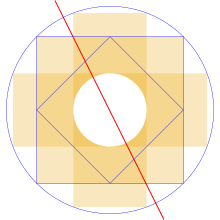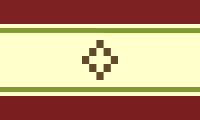Chacana
Chacana is a constellation of major significance in the Andes and is also the name of the Andean symbol that represents it. Its name comes from the Aymara "Jach'a Qhana," which means "great shining light," and for this reason in many parts of the Andes it is still pronounced "Achakana," instead of "Chacana." In Quechua, the Quechua word means "ladder" or "bridge-like object", (from aimara: pusi chakani 'la de los four bridges') "Andean cross" or "square cross". The chakana is an ancient aboriginal symbol of the indigenous peoples of the central Andes in the territories where both the Inca culture (southern Colombia, Ecuador, Peru, western Bolivia, Chile and Argentina) and some pre-Inca cultures (Peru and Bolivia) developed.). It is possible that in pre-Columbian Ancash, Huánuco and Nor Lima it was named tsakana.
The chakana is more than 4,000 years old, according to the architect Carlos Milla. Today, the Aymara culture continues to reproduce the chakana graphic on its fabrics. Likewise, the Aymara still keep the 13-month lunar calendar with 28 days each month, used by their ancestors: 13 times 28 equals 364, day 365 was considered day zero, something like a kind of beginning of the Andean New Year. That day is May 3, which is when the Southern Cross takes on the astronomical (geometric) shape of a perfect Latin cross.
Etymology
The word chakana is of Quechua origin, since it was a symbol widely used by the Inca culture, it clearly refers to the concept of "ladder", the symbol itself is a "tawa chakana& #34;, that is, a four (sided) ladder.
In central Quechua, tsakana means tool or material to be used as a bridge or union between two separate elements or parts. In the Andean provinces of Huánuco, twilight is known as tsakaana in the afternoon; and in the morning, tsaka- tsaka, implying the link between 'the world' of the night with the 'world' of the day The link between light and dark. This "four ladders" It has become popular in the Andean countries under the name of "chakana" or "chacana".
From Ancashino Quechua, a variety of Central Quechua, the Quechua word tsakana is composed of tsakan (to put a bridge) and the nominalizing suffix -na (instrument), which can be translated into Spanish as 'to put a bridge'.
The chakana or chacana
The "chacana" The Andean cross is a recurring symbol in the native cultures of the Andes. Its shape is that of a square and staggered cross, with twelve points. From Andean astronomy, the symbol itself represents the southern cross in May and is a reference to the Sun and the Southern Cross.
Its shape, which suggests a pyramid with stairs on all four sides and a circular center, would also have a higher meaning, in the sense of indicating the union between the low and the high, the earth and the sun, the human being and the top. Chakana, then, is understood not only as an architectural or geometric concept, but also takes on the meaning of "stairway to the highest level".
Chacanas have been found in various works of architecture, petroglyphs, textiles, ceramics, and sculptures throughout the South American highlands, recorded for the first time in the Caral culture, the mother civilization of America, then in Sechín Bajo and later in constructions Aymara of Tiahuanaco, in the Andean highlands, where exclusive astronomical observatories were also built for the observation of the southern cross, since the entire culture depended on the movement and position of the constellation to schedule their annual activities. They are also observed in Paracas, in the department of Ica, in Chavín in northern Peru. Chakanas have also been found in Ecuador, Argentina and Chile, as they were part of the Inca Empire.
In fact, a Late Archaic temple in northern Peru, in the Ventarrón Archaeological Complex, Pomalca district, in Lambayeque, has the oldest form of chacana found to date. The age of the temple has not yet been exactly determined, but it would be between 4,000 and 5,000 years.
In fact, the chakana is not a randomly found shape, but rather a geometric shape resulting from astronomical observation. Ancient men "brought heaven to earth" and they represented it with this symbol that contains opposing components that explain a vision of the universe, thus representing the masculine and the feminine, heaven and earth, above and below, energy and matter, time and space. The shape of the chakana contains in its geometry the concept of Number Pi and the real number twenty-seven[citation required].
Many of the typical shapes used by Andean artisans contain the geometric relationships marked by the chacana.
The choice of the cipher suyos ('region' in Quechua) or Qollasuyos ('region' in aimara) or regions of the Empire, as well as the dual definition of Hanan and Hurin (For example in Hanan Cuzco and Hurin Cuzco) they would also be based on the astronomical observations symbolized in the chacana, these calculations were also used as a basis for architectural and road design.
The Qhapaq Ñan, Camino del Inca or Camino del Señor, central axis of the road system of the Inca Empire, is also consistent with the geometry of the chacana. This road marks a line that crosses various cities of the Inca empire such as Cajamarca, Cuzco, Tiahuanaco, Oruro and Potosí (these last two are colonial cities, with previous Quechua and Aymara settlements). This line can be calculated taking the city of Cuzco as the center, the navel of the world, according to the Inca conception.
The chacana also indicates the four seasons of the year and the times of planting and harvesting. Some Andean towns celebrate May 3 as the day of the chacana, because on this day, the Southern Cross assumes the astronomical shape of a perfect cross and is a sign of harvest time. The southern cross was venerated by ancient inhabitants of Peru and, until today, the tradition of protecting crops is maintained by marking the cultivated area with various chakanas. This symbol has nothing to do with the Christian cross.
It is also the symbol of inkarri.
Andean Cosmovision
Worldview is the conception and image of the world that peoples have. Through this vision of the universe that surrounds them, peoples (especially those of antiquity) perceived and interpreted their natural and cultural environment.
The worldview is based on cosmogony, which is the mythological phase of the explanation of the world, and is organized in cosmology, as the basis of the syntax of thought. Diverse cultures of antiquity such as the Egyptian, the Inca, etc. they achieved an integrated vision of their environment that was used for the benefit of their own people. Astrological archeology is an important means of understanding the worldview of ancient peoples.
In the Andean world, the worldview is mainly linked to cosmography, which is the description of the cosmos, in this case corresponding to the sky of the southern hemisphere, whose visual and symbolic axis is marked by the constellation of the Southern Cross, called Chakana in antiquity, and whose name is applied to the Andean Stepped Cross, symbol of the Computer or Viracocha.
In the Andean universe there are simultaneous, parallel and interconnected worlds, in which life and communication between natural and spiritual entities are recognized.
Kanchas of the Andean Cosmovision
In order to understand the Andean conception within the architectural plan, it has been necessary to carry out a brief synthesis about the space or "kancha", using Quechua words and explaining their translation into Spanish.
The Andean space is perceived in three planes that are the vertical, the horizontal and the virtual, this space has a "kancha" or common place known as the "kay pacha" or nucleus, this space as the Life Computer is the axis of the horizontal, vertical and aureolar planes and therefore has an energetic value that influences the thought of the RUNAS (people of the Andean world).
Kanchas or spaces
Chakana or horizontal plane
This horizontal plane shows us how the energy fields are located in relation to the solar cycle, that is, the solstices and equinoxes.
Sikis or vertical plane
The sikis or bases govern the scale of power in pre-Columbian society; that is, starting with a superior being, the government and the people. This hierarchy is similar to that of other cultures and until today, in many of them, it remains in force, and this name is also used to differentiate the best things from other simpler ones.
Pacha or golden plane (virtual)
Pacha is parallel space and time. This plan is the summary of the previous two. The core or "kay pacha" it is the living space, the present, it is the essence of everything that is built in the Andean culture.
The chacana in flags
The chacana in shields
Government of Bolivia Logo
In Bolivia, on January 13, 2021, during the government of Luis Arce, a government image is established that is constituted by a chakana, establishing its use for ministries, embassies, decentralized institutions, control and control authorities.
The chacana in Peruvian politics
A Peruvian political party, Perú Posible, whose leader, Alejandro Toledo (former president of the republic), has used the chakana to project to the people an image of belonging to the so-called deep Peru. In fact, this party is known to this day as the party of the chakana.
Etnocacerismo, a Peruvian political doctrine characterized by ethnonationalism, uses the chakana as a representative symbol.
The chacana in other areas
The chacana, called "thirteen levels", also appears as a fundamental symbol in the so-called human re-education movements in Central and South America.
Chacana is the name of a volcano in Ecuador. Chacana, is a feather belt, used in Bolivia, as an ornament. used for dance
Andean astronomy
Astronomical practice in the Andes is linked to its cultural genesis, due to the need for this knowledge for agricultural activity and the usufruct of nature. Its presence in Andean history is relevant.
Among the testimonies obtained by archaeo-astronomical investigations, it is worth highlighting pre-Inca and Inca astronomical observations such as intersolstitial and stellar alignments, iconographic and shadow calendars, angular dating and astronomical mirrors as tools within a social practice and permanent ritual. All of this clearly indicates that the culture of ancient Peru recognized the cyclical nature of time and used this knowledge for the benefit of its people. Even more, it served him for the circular conception of time, different from the linear vision of time, as the West does.
Especially in the world the Andean cross is known as "Jach'aqhana" What does the light of the Andes mean?
Controversy over New Age fringe beliefs
Some scholars consider it an "invented tradition". Although the Chakana as an "Andean cross", presented as an Inca and pre-Inca symbol carrying cultural, spiritual or mystical interpretations, Widely popular in contemporary Andean culture, its roots are no older than the end of the 20th century.
Contenido relacionado
Pigeons
Vernacular
Jose Guadalupe Posada











